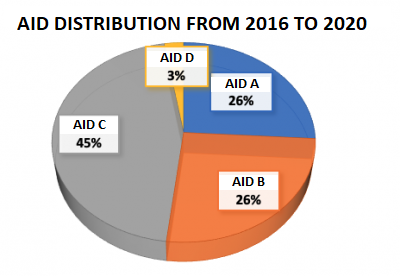Student aid
According to SDG 1 (poverty eradication) and SDG 10 (reduction of inequalities), the types of aid intended for students with gross per capita income below 1.5 minimum wages are being investigated at UFES. Until March 2021, data referring to the four types of support that covered 50,755 students were obtained from 2016 to 2020.
| Year | Aid A | Aid B | Aid C | Aid D |
|---|---|---|---|---|
| 2016 | 1718 | 2035 | 3655 | 212 |
| 2017 | 2622 | 2494 | 4636 | 297 |
| 2018 | 2904 | 2815 | 5410 | 318 |
| 2019 | 2899 | 2814 | 5138 | 283 |
| 2020 | 3035 | 3006 | 4245 | 219 |
Aid A - Receive housing, transport and consumables aid
Aid B - Receive housing allowance and consumables aid
Aid C - Receive transportation allowance and consumables aid
Aid D - Receive material consumption aid
Source: Prepared by Berson Nestann from data provided by the Student Assistance Program (Proaes), Office of Student Affairs and Citizenship (Proaeci).
The availability of these aids contributes to the achievement of the following Brazilian goals of the 2030 Agenda:
- Goal 1.1: by 2030, eradicate extreme poverty for all people everywhere;
- Goal 1.4: by 2030, ensure that all men and women, particularly the poor and vulnerable people, have access to social services;
- Goal 10.2: by 2030, empower and promote social, economic and political inclusion for all, regardless of age, gender, disability, race, ethnicity, origin, religion, economic status or otherwise;
- Goal 10.3: (UN target maintained): ensure equal opportunities and reduce inequalities in results, including through the elimination of discriminatory laws, policies and practices and promote adequate legislation, policies and actions in this regard.

Source: Berson Nestann
